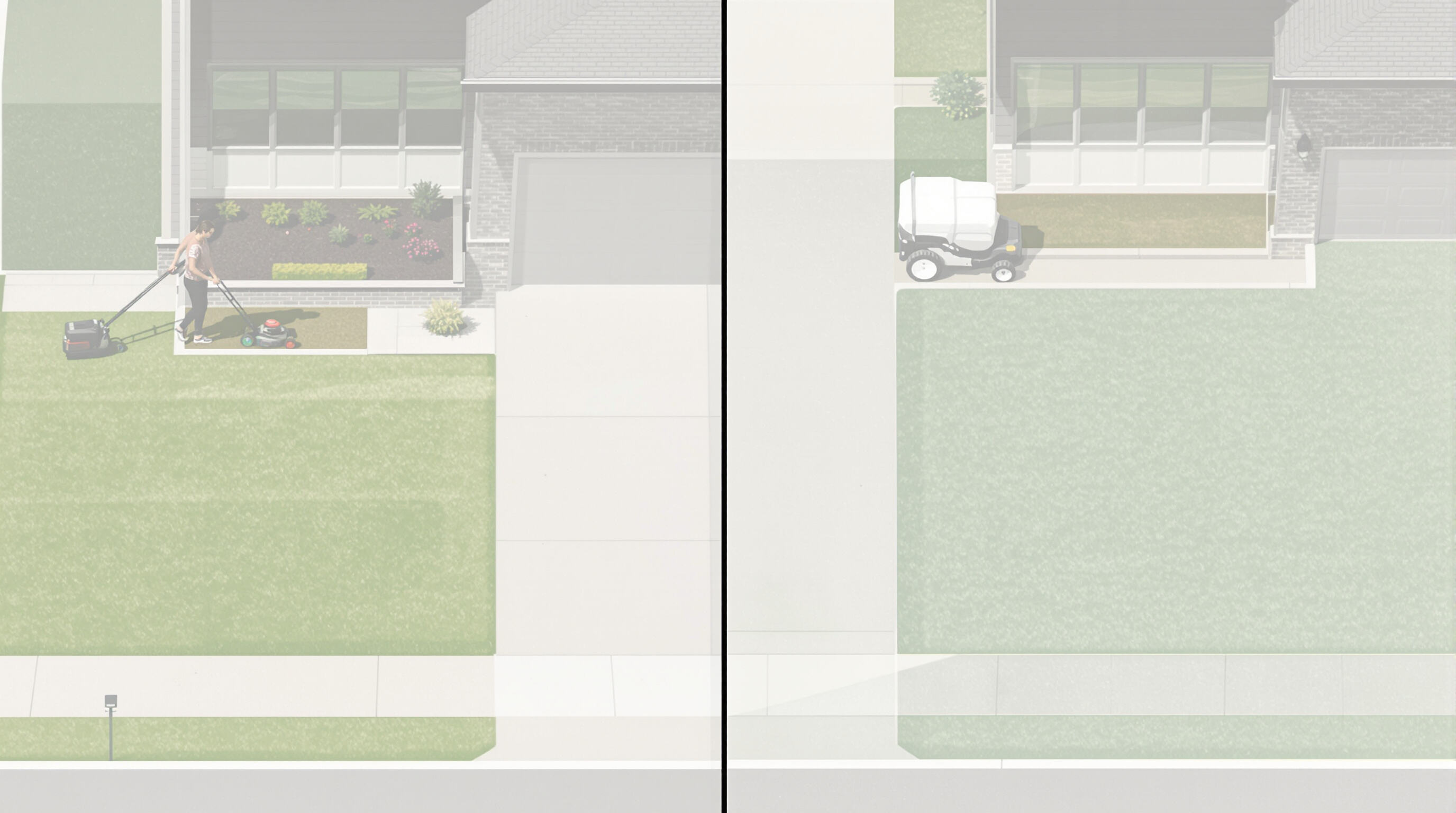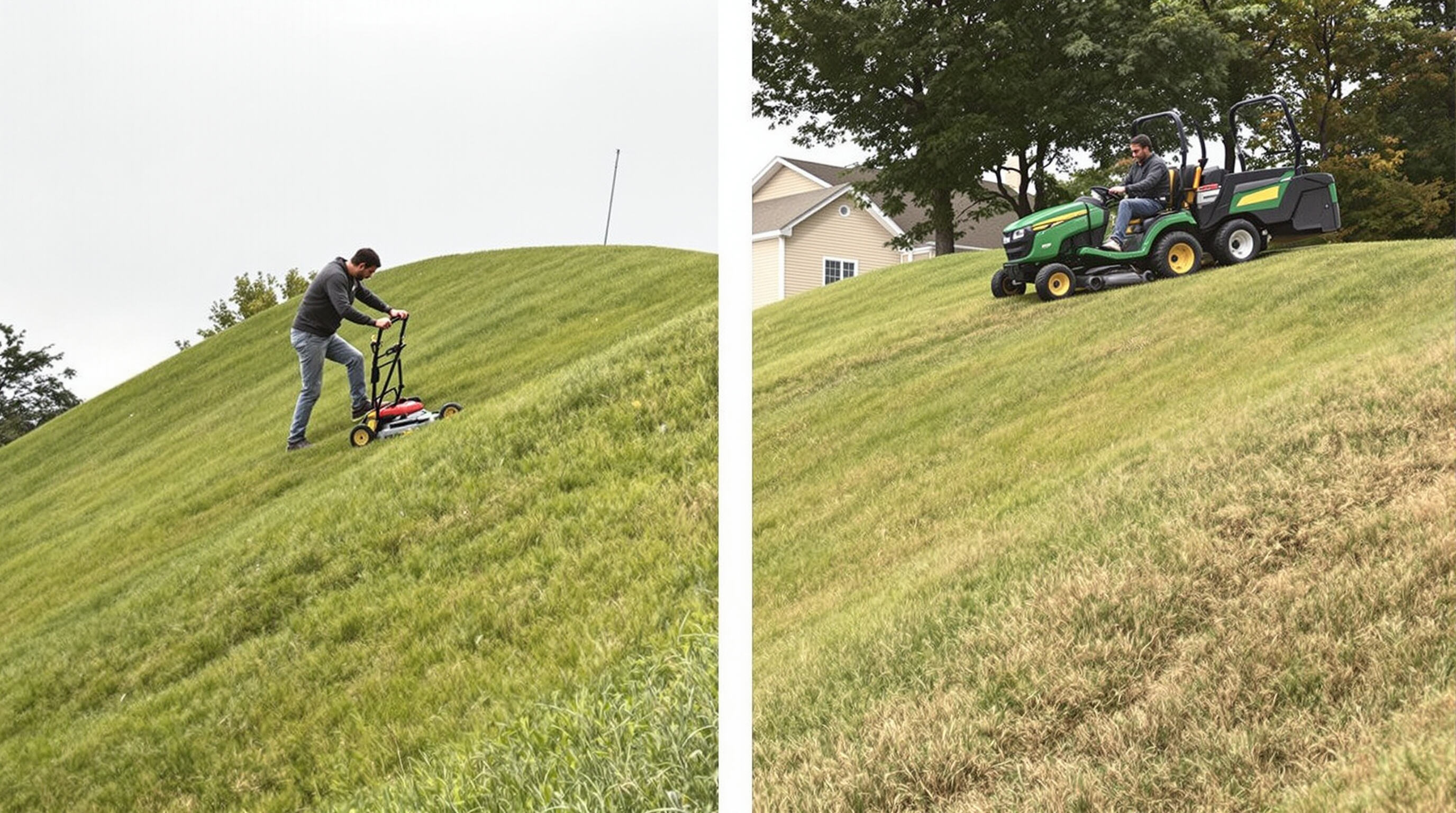Lawn Size and Mowing Efficiency: When to Choose a Ride-On Mower

How Lawn Size Impacts Mower Type Selection
The size of the yard plays a big role when deciding between a walk behind mower and something bigger like a ride on model. Most folks find that walk behinds work just fine for smaller yards, say anything below half an acre or so. They're small enough to maneuver around trees and flower beds without much trouble. But as lawns get larger, pushing that mower gets pretty tiring after a while. A recent study from TurfCare in 2023 showed interesting numbers too. People using self-propelled mowers actually burn about 43 percent more calories per acre compared to those riding around on bigger machines. And things get even worse on hills or bumpy ground where the operator constantly needs to adjust direction, making the whole job far more exhausting than expected.
Threshold Acreage for Switching to a Ride-On Mower
Experts recommend considering a ride-on mower for lawns exceeding 0.75 acres, balancing time savings and ergonomic benefits. The wider cutting decks of ride-ons typically 42” to 54”€”compared to 21”€“30” on walk-behinds, significantly reduce mowing time and effort.
| Lawn Size | Walk-Behind Time | Ride-On Time | Energy Expenditure Reduction |
|---|---|---|---|
| 1 Acre | 2.5 Hours | 1.2 Hours | 58% |
| 2 Acres | 5 Hours | 2.3 Hours | 62% |
These gains are amplified on larger or more complex lawns, making ride-on mowers a practical upgrade beyond the 0.75-acre threshold.
Time Savings With a Ride-On Mower on Large Lawns
According to research from Turf Maintenance Efficiency, those big ride-on mowers can finish cutting a 2-acre lawn nearly 3 times quicker than someone pushing a walk behind model. When dealing with tricky terrain full of trees, flower beds, and other landscaping features, zero turn radius machines really shine. These nimble units can zip through such areas about 1.4 times faster because they pivot so easily around obstacles. Gardeners who've switched to these power tools often mention feeling much less tired after finishing their cut. Many say they actually save energy for afternoon chores like trimming hedges or raking leaves instead of collapsing on the porch after mowing.
Case Study: Mowing a 2-Acre Property With Self-Propelled vs. Lawn Tractor
A controlled test on a 2-acre residential lot compared performance between a self-propelled walk-behind and a 42" lawn tractor:
- Self-propelled mower: 4.8 hours total, requiring 11 directional passes near landscaping features
- 42" Lawn tractor: 2.1 hours, only 3 passes needed in complex areas due to an 18" turning radius
The ride-on achieved 98% grass coverage versus 87% with the walk-behind, especially outperforming it on slopes ≥ 15 degrees where the walk-behind lost traction. Despite its larger engine, the lawn tractor used 22% less fuel per acre, underscoring its operational efficiency.
Terrain Type and Safety: Matching Mower Type to Ground Conditions

Impact of terrain slope on ride-on mower stability and safety
When operating on slopes steeper than 10 degrees, ride-on mowers tend to lose their grip significantly. According to some recent research from Greenspace Analytics back in 2023, stability drops by around 43% under these conditions. The problem comes down to physics really - these machines have a much higher center of gravity compared to walking tractors, which makes them prone to tipping when making side-to-side turns on hills. Rear engine models do handle gentle slopes better because they put more weight over the drive wheels. Still operators need to pay attention to how weight is distributed throughout the machine and operate at slower speeds to stay safe. Even small changes in terrain can make a big difference in maintaining control.
Walk-behind mower advantages on steep or uneven ground
Walk-behind mowers provide superior handling on slopes above 15 degrees thanks to their lower profile and direct operator influence over balance. Their narrower cutting decks (21”€“30") allow precise navigation around drainage ditches, tree roots, and other irregularities common in naturalistic landscapes, minimizing missed spots and improving safety.
Data comparison: Rollover risk on inclines above 15 degrees
| Slope Angle | Ride-On Mower Incident Rate | Walk-Behind Incident Rate |
|---|---|---|
| 15° | 8.2 incidents/1k hours | 1.1 incidents/1k hours |
| 20° | 17.6 incidents/1k hours | 2.4 incidents/1k hours |
| 25° | 39.1 incidents/1k hours* | 3.8 incidents/1k hours |
*Data reflects emergency room admissions for riding mower rollovers (CPSC 2022)
This data highlights the importance of matching mower type to slope severity, particularly for properties with significant elevation changes.
Performance Comparison: Ride-On vs. Walk-Behind Mowers Across Key Factors
Maneuverability and Stability on Uneven Terrain
Ride on mowers tend to stay steadier when tackling rough or bumpy ground because of their wider stance and better weight spread across the frame. But there's a trade-off here. These machines don't handle sudden changes in terrain as well as walk behind units do. Walk behinds have those smaller front wheels, usually between 7 and 11 inches, that bounce along over bumps and dips pretty effortlessly. Ride ons typically sport much bigger rear wheels, somewhere around 18 to 22 inches, which gives them better grip but makes maneuvering tricky in cramped spaces or when dealing with unexpected obstacles.
Operator Comfort and Physical Effort: Long-Term Implications
Ride-on mowers reduce musculoskeletal strain by 60% during sessions lasting over an hour, offering seated operation that minimizes fatigue. In contrast, walk-behind models demand continuous pushing forces of 15–30 pounds, increasing long-term injury risks. Integrated seats, armrests, and suspension systems on modern ride-ons further enhance comfort during extended use.
Cutting Height Precision and Wheel Size Impact
| Feature | Ride-On Mowers | Walk-Behind Mowers |
|---|---|---|
| Cutting Adjustments | 1-inch increments | 0.25–0.5-inch increments |
| Wheel Responsiveness | 2–3" ground variance | <1" ground variance |
| Best For | Consistent height | Precision edging |
Smaller wheels on walk-behinds follow subtle contour changes more accurately, making them better suited for fine grading and edge work, while ride-ons prioritize speed and uniformity.
Traction Differences Between Rear-Engine Riders and Self-Propelled Models
Rear-engine ride-on mowers deliver 40% more pulling power on wet or inclined surfaces due to optimized weight over the drive wheels. Self-propelled walk-behinds adjust speed based on pushing force but struggle on slopes above 15 degrees, where the lack of rider counterbalance limits traction and control.
Types of Ride-On Mowers: Best Fit for Lawn Layout and Usage Needs
Selecting the right ride-on mower depends on your lawn’s layout, size, and usage patterns. According to the 2024 Lawn Care Equipment Report, three main types dominate residential applications, each suited to different yard configurations:
Zero-Turn Mowers for Large, Open, or Uneven Lawns
Zero-turn mowers pivot on their axis, enabling unmatched maneuverability around trees, flowerbeds, and irregular borders. With cutting decks ranging from 42 to 60 inches, they cut mowing time by 30–40% on properties of 2 acres or more, making them ideal for expansive or obstacle-rich lawns.
Lawn Tractors for Moderate Terrain and Wide-Open Spaces
Lawn tractors feature 18–25 HP engines and 42–54-inch decks, delivering a balance of speed and stability on flat or gently rolling terrain. Their versatility extends beyond mowing—they support attachments like snow plows and tow-behinds—making them well-suited for properties up to 3 acres with open layouts.
Rear-Engine Riders for Tighter Residential Layouts
Compact rear-engine riders come with 30–38-inch decks and fit through narrow gates and into small sheds. Despite their size, they maintain mowing speeds of 10–12 MPH and excel in residential lots between 0.5 and 1 acre with limited turning space.
| Mower Type | Best For | Turning Radius | Deck Size Range |
|---|---|---|---|
| Zero-Turn | Complex lawns/obstacles | 0° | 42–60 inches |
| Lawn Tractor | Flat, open areas | 3–5 feet | 42–54 inches |
| Rear-Engine Rider | Tight residential layouts | 2–3 feet | 30–38 inches |
For mixed terrain, consider models with 4-wheel steering or adjustable tire pressure. Whenever possible, test different types during peak growing seasons to evaluate real-world performance in your specific conditions.
FAQs
What size lawn is suitable for a ride-on mower?
For lawns exceeding 0.75 acres, a ride-on mower is recommended for its efficiency and ergonomic benefits.
Are ride-on mowers safe to use on slopes?
Ride-on mowers can lose stability on slopes steeper than 10 degrees, making them less safe under such conditions compared to walk-behind mowers.
How do ride-on mowers compare to walk-behind mowers in terms of time efficiency?
Ride-on mowers can significantly reduce mowing time, particularly on large lawns or intricate terrains, due to their wider cutting decks and zero-turn capabilities.
Which type of ride-on mower is best for residential use?
Zero-turn mowers are ideal for large or complex lawns; lawn tractors suit flat areas with open layouts; rear-engine riders fit tighter residential spaces.

